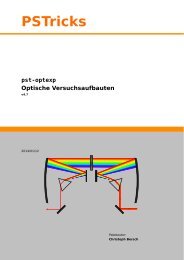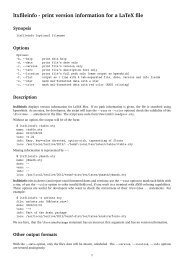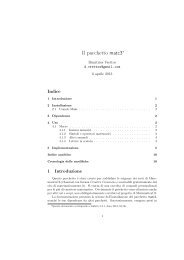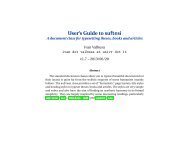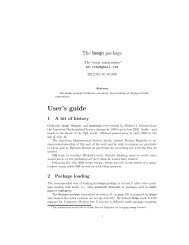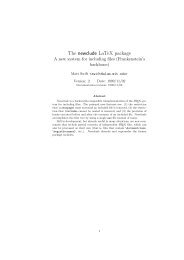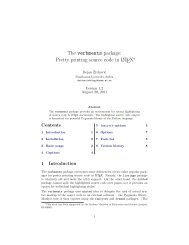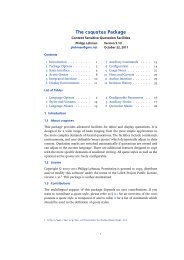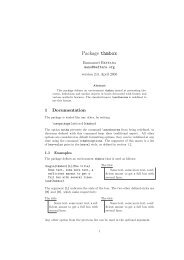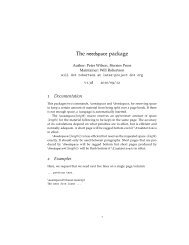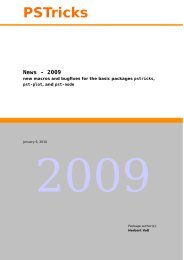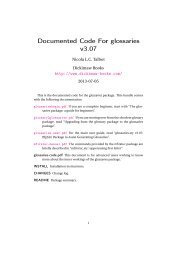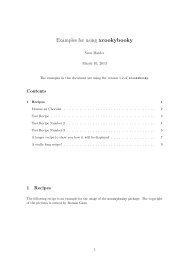The attrib LaTeX package - CTAN
The attrib LaTeX package - CTAN
The attrib LaTeX package - CTAN
You also want an ePaper? Increase the reach of your titles
YUMPU automatically turns print PDFs into web optimized ePapers that Google loves.
<strong>The</strong> <strong>attrib</strong> <strong>LaTeX</strong> <strong>package</strong><br />
<strong>attrib</strong>ution of block elements (Frankenstein’s hat)<br />
Matt Swift <br />
Version: 1.3 Date: 2001/08/31<br />
Documentation revision: 2001/08/31<br />
Abstract<br />
<strong>The</strong> \<strong>attrib</strong> macro <strong>attrib</strong>utes block elements, for example when citing<br />
a reference after a block quotation.<br />
Contents<br />
I Discussion 2<br />
1 Attributions 2<br />
2 Examples 3<br />
3 Programmer’s Interface 8<br />
II Implementation 9<br />
4 Version control 9<br />
5 Macros 9<br />
III Something you can’t use 12<br />
1
\<strong>attrib</strong><br />
\normalcitations<br />
Part I<br />
Discussion<br />
1 Attributions<br />
FIX: maybe \<strong>attrib</strong> when not in a block environment should do this, with appropriate<br />
hooks added, etc.: use the blkcntrl hooks. and Pre stuff.<br />
\def\<strong>attrib</strong> [1] {%<br />
(\begingroup<br />
\<strong>attrib</strong>citations<br />
#1%<br />
\endgroup<br />
)%<br />
}<br />
Here’s an example of the kind that inspires the question: ({\<strong>attrib</strong>citations%<br />
\citework{3}{unnam},andseepage~\pageref{q:aporia}}). Thisway\<strong>attrib</strong>citations<br />
and \normalcitations could still be defined only within \<strong>attrib</strong>, which seems<br />
the most sensible.<br />
Iwrote\<strong>attrib</strong> in order to have an abstract way to <strong>attrib</strong>ute the source<br />
of quotations of prose or verse in an academic style. <strong>The</strong> formatting is that<br />
recommended by the Chicago Manual of Style, except that <strong>attrib</strong>utions of block<br />
quotations of prose are given flush right, to allow the reader to locate a quotation<br />
more quickly when returning to the text.<br />
Use \<strong>attrib</strong> {〈<strong>attrib</strong>ution〉} at the end of any block of text, such as the quote,<br />
quotation, verse, anddialogue environments (the last is defined in the dialogue<br />
<strong>package</strong>, also part of the Frankenstein bundle).<br />
For verse, you ought to use either a blank line or a final \\ before your<br />
<strong>attrib</strong>ution. For quote, quotation, anddialgoue, don’t leave a blank line.<br />
\<strong>attrib</strong> will place the <strong>attrib</strong>ution flush right to the margins of the block. If<br />
there is enough room on the last line, the <strong>attrib</strong>ution will be given on the last line,<br />
otherwise it moves down to a line of its own.<br />
You can put pretty much anything as the text of the <strong>attrib</strong>ution, including<br />
citations and footnotes.<br />
For those using the achicago and abbrevs <strong>package</strong>s (also in the Frankenstein<br />
bundle), \citework works very well. If you’re using regular \cite or another<br />
<strong>package</strong>, I recommend using the FIX hook below to remove the usual parens or<br />
braces around citations that occur within the \<strong>attrib</strong> argument. It makes more<br />
sensetomethatway.<br />
If parens are normally around citations, they are removed when citations occur<br />
within <strong>attrib</strong>utions. <strong>The</strong> idea is that you can simply write \<strong>attrib</strong>{\cite{key}}<br />
and what normally surrounds the citation will be replaced with \PreTrib and<br />
\PostTrib (which of course could be the same thing, but doing it this way allows<br />
<strong>attrib</strong>utions to contain things other than just a citation and still everything will<br />
look right).<br />
Whenever within an <strong>attrib</strong>ution you want the normal behavior of citations<br />
back, write \normalcitations. \normalcitations is automatically used within<br />
footnotes within <strong>attrib</strong>utions; it’s used in the epigraph <strong>package</strong>; and occasionally<br />
a user will want to invoke it, when the <strong>attrib</strong>ution is unusual. I find that most<br />
2
\<strong>attrib</strong>citations<br />
<strong>attrib</strong>utions are either just a citation, or they do not have a citation at all. Sometimes<br />
I’ve wanted an <strong>attrib</strong>ution consisting of a citation plus some other text, for<br />
which cases I provided \normalcitations as a user command.<br />
To do: Right now the only time there is any concept of “normal” or altered<br />
behavior of \cite commands is with the achicago <strong>package</strong>. I should make it so<br />
that \<strong>attrib</strong> by default leaves off braces, brackets, etc, around citations, for the<br />
standard definition of \cite also.<br />
FIX: dox, example.<br />
2 Examples<br />
Following are several examples that use \<strong>attrib</strong>. <strong>The</strong>y should be self-explanatory.<br />
\begin{quotation}<br />
[My plays] deal with distress. Some people object to this in my writing.<br />
At a party an English intellectual---so called---asked me why I write always<br />
about distress. As if it were perverse to do so! He wanted to know if my<br />
father had beaten me or my mother had run away from home to give me an<br />
unhappy childhood. I told him no, that I had had a very happy childhood.<br />
<strong>The</strong>n he thought me more perverse than ever. I left the party as soon as<br />
possible and got into a taxi. On the glass partition between me and the<br />
driver were three signs: one asked for help for the blind, another help for<br />
orphans, and the third for relief for the war refugees. One does not have to<br />
look for distress. It is screaming at you even in the taxis of London.<br />
\<strong>attrib</strong>{\cite[24]{driver:beckett:madeleine}}<br />
\end{quotation}<br />
LOOKS LIKE:<br />
[My plays] deal with distress. Some people object to this in my<br />
writing.<br />
At a party an English intellectual—so called—asked me why I write<br />
always about distress. As if it were perverse to do so! He wanted to<br />
know if my father had beaten me or my mother had run away from<br />
home to give me an unhappy childhood. I told him no, that I had had<br />
a very happy childhood. <strong>The</strong>n he thought me more perverse than ever.<br />
I left the party as soon as possible and got into a taxi. On the glass<br />
partition between me and the driver were three signs: one asked for<br />
help for the blind, another help for orphans, and the third for relief<br />
for the war refugees. One does not have to look for distress. It is<br />
screaming at you even in the taxis of London. (Driver 1961, 24)<br />
\providelength\mtslen<br />
\newcommand\makethisspace [1] {%<br />
\settowidth{\mtslen}{#1}%<br />
\hspace*{\mtslen}%<br />
}<br />
\begin{verse}<br />
3
\makethisspace{Where Joy for ever dwells:} Hail horrours, hail \\<br />
Infernal World, and thou profoundest Hell \\<br />
Receive thy new Possessor: One who brings \\<br />
A mind not to be chang’d by Place or Time. \\<br />
<strong>The</strong> mind is its own place, and in it self \\<br />
Can make a Heav’n of Hell, a Hell of Heav’n. \\<br />
What matter where, if I be still the same, \\<br />
And what I should be, all but less then he \\<br />
Whom Thunder hath made greater? Here at least \\<br />
We shall be free; th’ Almighty hath not built \\<br />
Here for his envy, will not drive us hence: \\<br />
Here we may reign secure, and in my choyce \\<br />
To reign is worth ambition though in Hell: \\<br />
Better to reign in Hell, then serve in Heav’n.<br />
\<strong>attrib</strong>{\book{Paradise Lost} 1.250--63,<br />
\cite{milton:riverside:paralost}}<br />
\end{verse}<br />
LOOKS LIKE:<br />
Hail horrours, hail<br />
Infernal World, and thou profoundest Hell<br />
Receive thy new Possessor: One who brings<br />
A mind not to be chang’d by Place or Time.<br />
<strong>The</strong> mind is its own place, and in it self<br />
Can make a Heav’n of Hell, a Hell of Heav’n.<br />
What matter where, if I be still the same,<br />
And what I should be, all but less then he<br />
Whom Thunder hath made greater? Here at least<br />
We shall be free; th’ Almighty hath not built<br />
Here for his envy, will not drive us hence:<br />
Here we may reign secure, and in my choyce<br />
To reign is worth ambition though in Hell:<br />
Better to reign in Hell, then serve in Heav’n.<br />
(Paradise Lost 1.250–63, Milton 1998)<br />
You can have a footnote inside the <strong>attrib</strong>ution. <strong>The</strong> boxed example below is<br />
meant to approximate a whole page (that is, the footnote appears at the bottom<br />
of the page, not directly underneath the quotation).<br />
\begin{verse}<br />
Jacke boy, ho boy newes,\\<br />
\quad the cat is in the well,\\<br />
let us ring now for her Knell,\\<br />
\quad ding dong ding dong Bell.<br />
\<strong>attrib</strong>{\cite[149]{opie:nursery}\footnote {%<br />
Perhaps more familiar is the nursery rhyme that begins ‘‘Ding,<br />
dong, bell, / Pussy’s in the well,’’ which Opie and Opie also cite. It does<br />
not seem clear in that rhyme, however, without contextual knowledge, that the<br />
4
cat has died and the bell rings its knell.}}<br />
\end{verse}<br />
LOOKS LIKE:<br />
Jacke boy, ho boy newes,<br />
the cat is in the well,<br />
let us ring now for her Knell,<br />
ding dong ding dong Bell.<br />
(Opie and Opie 1952, 149 a )<br />
a Perhaps more familiar is the nursery rhyme that begins “Ding, dong, bell, / Pussy’s in the<br />
well,” which Opie and Opie also cite. It does not seem clear in that rhyme, however, without<br />
contextual knowledge, that the cat has died and the bell rings its knell.<br />
Here is a quotation from Beckett 1953:<br />
\newwork\watt{Watt}<br />
\begin{quote}<br />
One day Watt, coming out from behind a bush, almost ran into Mr~Knott,<br />
which for an instant troubled Watt greatly, for he had not quite finished<br />
adjusting his dress. But he need not have been troubled. For Mr~Knott’s<br />
hands were behind his back, and his head bowed down, towards the ground.<br />
<strong>The</strong>n Watt in his turn looking down at first saw nothing but the short green<br />
grass, but when he had looked a little longer he saw a little blue flower<br />
and close by a fat worm burrowing into the earth. So this was what had<br />
attracted Mr~Knott’s attention, perhaps. So there for a short time they<br />
stood together, the master and the servant, the bowed heads almost touching<br />
\lips, until the worm was gone and only the flower remained. One day the<br />
flower would be gone and only the worm remain, but on this particular day<br />
it was the flower that remained, and the worm that went. And then Watt,<br />
looking up, saw that Mr~Knott’s eyes were closed, and heard his breathing,<br />
soft and shallow, like the breathing of a child asleep.<br />
\<strong>attrib</strong>{\citework{145--46}{watt}}<br />
\end{quote}<br />
LOOKS LIKE:<br />
One day Watt, coming out from behind a bush, almost ran into<br />
Mr Knott, which for an instant troubled Watt greatly, for he had not<br />
quite finished adjusting his dress. But he need not have been troubled.<br />
For Mr Knott’s hands were behind his back, and his head bowed down,<br />
towards the ground. <strong>The</strong>n Watt in his turn looking down at first saw<br />
nothing but the short green grass, but when he had looked a little<br />
longer he saw a little blue flower and close by a fat worm burrowing<br />
into the earth. So this was what had attracted Mr Knott’s attention,<br />
perhaps. So there for a short time they stood together, the master and<br />
the servant, the bowed heads almost touching . . . , until the worm was<br />
gone and only the flower remained. One day the flower would be gone<br />
and only the worm remain, but on this particular day it was the flower<br />
that remained, and the worm that went. And then Watt, looking up,<br />
saw that Mr Knott’s eyes were closed, and heard his breathing, soft<br />
and shallow, like the breathing of a child asleep. (Watt, 145–46)<br />
5
Finally, here’s a very simple example from the same book. When the context<br />
is clear, you might just want page numbers in the <strong>attrib</strong>ution.<br />
\begin{quote}<br />
For Watt now found himself in the midst of things which, if they<br />
consented to be named, did so as it were with reluctance.\lips Looking at<br />
a pot, for example, \lips it was in vain that Watt said, Pot, pot. Well,<br />
perhaps not quite in vain, but very nearly. \lips It resembled a pot, it<br />
was almost a pot, but it was not a pot of which one could say, Pot, pot,<br />
and be comforted. It was in vain that it answered, with unexceptionable<br />
adequacy, all the purposes, and performed all the offices, of a pot, it<br />
was not a pot. And it was just this hairbreadth departure from the<br />
nature of a true pot that so excruciated Watt\lips. For he could always<br />
hope, of a thing of which he had never known the name, that he would<br />
learn the name, some day, and so be tranquillized.<br />
\<strong>attrib</strong>{81--82}<br />
\end{quote}<br />
LOOKS LIKE:<br />
For Watt now found himself in the midst of things which, if they consented<br />
to be named, did so as it were with reluctance. . . . Looking at<br />
a pot, for example, . . . it was in vain that Watt said, Pot, pot. Well,<br />
perhaps not quite in vain, but very nearly. . . . It resembled a pot, it<br />
was almost a pot, but it was not a pot of which one could say, Pot,<br />
pot, and be comforted. It was in vain that it answered, with unexceptionable<br />
adequacy, all the purposes, and performed all the offices, of a<br />
pot, it was not a pot. And it was just this hairbreadth departure from<br />
the nature of a true pot that so excruciated Watt. . . . For he could<br />
always hope, of a thing of which he had never known the name, that<br />
he would learn the name, some day, and so be tranquillized.<br />
(81–82)<br />
Here’s an example of use with the dialogue environment. Not much different<br />
than the others, but the quotes are nice, and I’ll demonstrate a use of<br />
\normalcitations. b’s speeches are interspersed through the play with a’s and<br />
c’s, but it’s interesting to read them consecutively.<br />
\begin{dialogue}<br />
\speak{b} on the stone together in the sun on the stone at the edge of the<br />
little wood and as far as eye could see the wheat turning yellow vowing every<br />
now and then you loved each other just a murmur not touching or anything of<br />
that nature you one end of the stone she the other long low stone like<br />
millstone no looks just there on the stone in the sun with the little wood<br />
behind gazing at the wheat or eyes closed all still no sign of life not a<br />
soul abroad no sound<br />
\speak{b} all still just leaves and ears and you too still on the stone in a<br />
daze no sound not a word only every now and then to vow you loved each other<br />
just a murmur one thing could ever bring tears till they dried up altogether<br />
6
that thought when it came up among the others floated up that scene<br />
\speak{b} on the stone in the sun gazing at the wheat or the sky or the eyes<br />
closed nothing to be seen but the wheat turning yellow and the blue sky<br />
vowing every now and then you loved each other just a murmur tears without<br />
fail till they dried up altogether suddenly there in whatever thoughts you<br />
might be having whatever scenes perhaps way back in childhood or the womb<br />
worst of all or that old Chinaman long before Christ born with long white<br />
hair<br />
\speak{b} no sight of the face or any other part never turned to her nor she to<br />
you always parallel like on an axle-tree never turned to each other just<br />
blurs on the fringes of the field no touching or anything of that nature<br />
always space between if only an inch no pawing in the manner of flesh and<br />
blood no better than shades no worse if it wasn’t for the vows<br />
\speak{b} \lips on the fringe of the field and every now and then in the great<br />
peace like a whisper so faint she loved you<br />
\<strong>attrib</strong>{\play{That Time}{} \normalcitations\cite{beckett:csp:that}}<br />
\end{dialogue}<br />
LOOKS LIKE:<br />
b: on the stone together in the sun on the stone at the edge of the little<br />
wood and as far as eye could see the wheat turning yellow vowing<br />
every now and then you loved each other just a murmur not touching<br />
or anything of that nature you one end of the stone she the other long<br />
low stone like millstone no looks just there on the stone in the sun with<br />
the little wood behind gazing at the wheat or eyes closed all still no<br />
sign of life not a soul abroad no sound<br />
b: all still just leaves and ears and you too still on the stone in a daze<br />
no sound not a word only every now and then to vow you loved each<br />
other just a murmur one thing could ever bring tears till they dried up<br />
altogether that thought when it came up among the others floated up<br />
that scene<br />
b: on the stone in the sun gazing at the wheat or the sky or the eyes<br />
closed nothing to be seen but the wheat turning yellow and the blue sky<br />
vowing every now and then you loved each other just a murmur tears<br />
without fail till they dried up altogether suddenly there in whatever<br />
thoughts you might be having whatever scenes perhaps way back in<br />
childhood or the womb worst of all or that old Chinaman long before<br />
Christ born with long white hair<br />
b: no sight of the face or any other part never turned to her nor she to<br />
you always parallel like on an axle-tree never turned to each other just<br />
blurs on the fringes of the field no touching or anything of that nature<br />
always space between if only an inch no pawing in the manner of flesh<br />
and blood no better than shades no worse if it wasn’t for the vows<br />
b: . . . on the fringe of the field and every now and then in the great peace<br />
like a whisper so faint she loved you<br />
(That Time (Beckett 1984))<br />
7
3 Programmer’s Interface<br />
\AttribMinSkip<br />
You might want to use \<strong>attrib</strong> as part of some other command you define. For<br />
example, I wrote a command for epigraphs, \epigraph {〈text〉}<strong>attrib</strong>ution, which<br />
used \<strong>attrib</strong> internally. For this type of thing, and also in general I suppose, you<br />
might want to change the behavior of \<strong>attrib</strong>.<br />
\AttribMinSkip is a length, the minimum amount of horizontal space that<br />
must come after any previous text and before the <strong>attrib</strong>ution. <strong>The</strong> default value<br />
is 2em.<br />
\PreTrib When you write \<strong>attrib</strong><strong>attrib</strong>ution, \PreTrib will immediately precede<br />
\PostTrib 〈<strong>attrib</strong>ution〉 and \PostTrib will immediately follow it. Notice how the attri-<br />
\AttribInit<br />
butions in the examples above were in parentheses, but we didn’t have to write<br />
them. <strong>The</strong> default value of \PreTrib is a left parenthesis and the default value of<br />
\PostTrib is a right parenthesis. \PreTrib and 〈<strong>attrib</strong>ution〉 are executed inside<br />
a group that doesn’t include ), and \PostTrib is executed in a group all by itself,<br />
like this: {\PreTrib\relax#1}{\PostTrib}. Honestly I can’t tell you right now<br />
why it’s done this way, but I’m sure I have some good reason for it!<br />
\AttribInit is an hook, empty by default, that gets executed after some<br />
standard setup but before the core of the \<strong>attrib</strong> macro. It is executed within<br />
a group that includes \PreTrib, 〈<strong>attrib</strong>ution〉, and\PostTrib, so perhaps it is<br />
appropriate for a font style change or something (I haven’t made use of it myself).<br />
8
\fileinfo<br />
\DoXUsepackagE<br />
\HaveECitationS<br />
\fileversion<br />
\filedate<br />
\docdate<br />
\PPOptArg<br />
\AttribMinSkip<br />
\PreTrib<br />
\PostTrib<br />
Part II<br />
Implementation<br />
4 Version control<br />
<strong>The</strong>se definitions must be the first ones in the file.<br />
1 \def\fileinfo{<strong>attrib</strong>ution of block elements (Frankenstein’s hat)}<br />
2 \def\DoXPackageS {<strong>attrib</strong>,dialogue}<br />
3 \def\initelyHavECitationS {}<br />
4 \def\fileversion{v1.3}<br />
5 \def\filedate{2001/08/31}<br />
6 \def\docdate{2001/08/31}<br />
7 \edef\PPOptArg {%<br />
8 \filedate\space \fileversion\space \fileinfo<br />
9 }<br />
If we’re loading this file from a \ProcessDTXFile command (see the compsci<br />
<strong>package</strong>), then \JusTLoaDInformatioN will be defined; othewise we assume it is<br />
not (that’s why the FunkY NamE).<br />
If we’re loading from \ProcessDTXFile, we want to load the <strong>package</strong>s listed in<br />
\DoXPackageS (needed to typeset the documentation for this file) and then bail<br />
out. Otherwise, we’re using this file in a normal way as a <strong>package</strong>, so do nothing.<br />
\DoXPackageS, if there are any, are declared in the dtx file, and, if you’re reading<br />
the typeset documentation of this <strong>package</strong>, would appear just above. (It’s OK to<br />
call \use<strong>package</strong> with an empty argument or \relax, bytheway.)<br />
10 \makeatletter% A special comment to help create bst files. Don’t change!<br />
11 \@ifundefined{JusTLoaDInformatioN} {%<br />
12 }{% ELSE (we know the compsci <strong>package</strong> is already loaded, too)<br />
13 \UndefineCS\JusTLoaDInformatioN<br />
14 \SaveDoXVarS<br />
15 \eExpand\csname DoXPackageS\endcsname\In {%use \csname in case it’s undefined<br />
16 \use<strong>package</strong>{#1}%<br />
17 }%<br />
18 \RestoreDoXVarS<br />
19 \makeatother<br />
20 \endinput<br />
21 }% A special comment to help create bst files. Don’t change!<br />
Now we check for L ATEX2e and declare the <strong>LaTeX</strong> <strong>package</strong>.<br />
22 \NeedsTeXFormat{<strong>LaTeX</strong>2e}<br />
23 \ProvidesPackage{<strong>attrib</strong>}[\PPOptArg]<br />
24 \RequirePackage{moredefs}<br />
5 Macros<br />
25 \newlength{\AttribMinSkip}<br />
26 \setlength{\AttribMinSkip}{2em}<br />
27 \newcommand\PreTrib {%<br />
28 (%<br />
9
\AttribInit<br />
\at@init<br />
29 }<br />
30 \newcommand\PostTrib {%<br />
31 )%<br />
32 }<br />
This heart of this code is from the TEXbook (Knuth 1986, 106). If you contribute<br />
anything to the horizontal or vertical list before the \unskip, it will cancel the<br />
effect of the \unskip. You probably don’t want to do that.<br />
33 \ReserveCS\AttribInit<br />
34 \newcommand\at@init {%<br />
35 \SaveCS\footnote<br />
36 \def\footnote {%<br />
37 \normalcitations\MDSavedfootnote<br />
38 }%<br />
39 \<strong>attrib</strong>citations<br />
If there’s a blank line before the \<strong>attrib</strong>, wewanttoleave\parskip extra space<br />
above.<br />
40 \ifhmode<br />
41 \unskip<br />
42 \fi<br />
43 \AttribInit<br />
44 }<br />
\<strong>attrib</strong>citations Sets up citations for within an <strong>attrib</strong>-like environment. Should probably be called<br />
within a group.<br />
45 \newcommand\<strong>attrib</strong>citations {%<br />
46 \SaveCS\PreCiteWork<br />
47 \SaveCS\PostCiteWork<br />
48 \def\PreCiteWork {%<br />
49 \csname<br />
50 }%<br />
51 \def\PostCiteWork {%<br />
52 \relax\end{lrbox}\usebox{\sc@box@a}%<br />
53 }%<br />
54 \SaveCS\PreCite<br />
55 \SaveCS\PostCite<br />
56 \let\PreCite\ShortEmpty<br />
57 \let\PostCite\ShortEmpty<br />
58 }<br />
\normalcitations FIX Would you ever want this and \<strong>attrib</strong>citations defined outside of the scope<br />
of an \<strong>attrib</strong>? Perhaps \let it to a warning outside of \<strong>attrib</strong>.<br />
59 \newcommand* \normalcitations {%<br />
60 \RestoreCS\PreCite<br />
61 \RestoreCS\PostCite<br />
62 \RestoreCS\PreCiteWork<br />
63 \RestoreCS\PostCiteWork<br />
64 }<br />
\<strong>attrib</strong> Knuth says that \vadjust is more efficient here than \hbox, but I don’t understand<br />
why: I guess it’s simply a trivial non-discardable item on the horizontal list<br />
(Knuth 1986, 316). FIX: I can get a page break after the text and before the<br />
<strong>attrib</strong>ution; it’s happening with <strong>attrib</strong>star and when the <strong>attrib</strong>ution is dropped<br />
10
to the next line, but not sure if that’s the only case (first quote in “impotence”<br />
section of library copy of dissertation). Also pages 53, 57 of same.<br />
65 \newcommand\<strong>attrib</strong> [1] {%<br />
66 \begingroup<br />
67 \at@init<br />
68 \nobreak\hfil\penalty50%<br />
69 \hskip\AttribMinSkip<br />
70 \vadjust{}\nobreak\hfil<br />
71 {\PreTrib\relax#1}{\PostTrib}%<br />
72 \parfillskip\z@<br />
73 \nobreak<br />
74 \finalhyphendemerits0%<br />
75 \par<br />
76 \endgroup<br />
77 }<br />
11
Part III<br />
Something you can’t use<br />
\<strong>attrib</strong>star <strong>The</strong>re is one macro, \<strong>attrib</strong>star, in this <strong>package</strong> that you can’t use because you<br />
don’t have a <strong>package</strong> that I haven’t released yet. I don’t want to release it because<br />
it still has a couple of small but significant problems that can lead to mistakes. If I<br />
took \<strong>attrib</strong>star out of this <strong>package</strong>, however, I’d have to maintain two different<br />
versions of <strong>attrib</strong>. So here is a glimpse of a future bright star.<br />
\DescribeMacro\<strong>attrib</strong>star<br />
Use this instead of a standard footnote in an <strong>attrib</strong>ution when you want the<br />
note to appear on the page of the quotation. That is, it is not a substantive note,<br />
but something like “italics mine” or “ellipses in original” which belongs there on<br />
the page, not in endnotes, in case footnotes are ever moved there.<br />
1 \newcommand\<strong>attrib</strong>star [2] {%<br />
2 \begingroup<br />
3 \addto@macro\PostTrib {%<br />
4 \normalcitations<br />
5 \starnote{#2}%<br />
6 }%<br />
7 \<strong>attrib</strong>{#1}%<br />
8 \endgroup<br />
9 }<br />
12
References<br />
Beckett, Samuel. 1953. Watt. Paris: Olympia Press. Reprint, New York: Grove<br />
Press, 1959.<br />
. 1984. “That Time.” In Collected Shorter Plays, 225–35. New York:<br />
Grove Press.<br />
Driver, Tom F. 1961. “Beckett by the Madeleine.” Columbia University Forum<br />
4 (3): 21–25 (summer). Note: Driver “reconstructs” Beckett’s words “from<br />
notes made immediately after” their conversation (p. 22).<br />
Knuth, Donald Ervin. 1986. <strong>The</strong> TEXbook. 16th printing, revised. Volume A of<br />
Computers & Typesetting. Illustrated by Duane Bibby. Reading MA: Addison<br />
Wesley. First published in 1984.<br />
Milton, John. 1998. “Paradise Lost.” In <strong>The</strong> Riverside Milton, editedbyRoy<br />
Flannagan, 296–710. Boston: Houghton Mifflin.<br />
Opie, Iona, and Peter Opie, eds. 1952. <strong>The</strong> Oxford Dictionary of Nursery Rhymes.<br />
Corrected ed. Oxford: Clarendon Press. First published in 1951.<br />
University of Chicago Press. 1993. <strong>The</strong> Chicago Manual of Style. 14th ed.<br />
Chicago: University of Chicago Press.<br />
13
Index<br />
Numbers written in italic refer to the page where the corresponding entry is described;<br />
numbers underlined refer to the code line of the definition; numbers in<br />
roman refer to the code lines where the entry is used.<br />
Symbols<br />
\@ifundefined ..... 11<br />
A<br />
\addto@macro ....... 3<br />
\at@init ....... 33,67<br />
\<strong>attrib</strong> ....... 2, 7,65<br />
\<strong>attrib</strong>citations ..<br />
....... 3, 39, 45<br />
\AttribInit ...... 8, 33<br />
\AttribMinSkip 8, 25,69<br />
\<strong>attrib</strong>star ........ 1<br />
B<br />
\begingroup ...... 2,66<br />
C<br />
\csname ........ 15,49<br />
D<br />
\def . . . . . 1–6, 36, 48, 51<br />
\docdate .......... 1<br />
\DoXPackageS ....... 2<br />
\DoXUsepackagE ..... 1<br />
E<br />
\edef ............. 7<br />
\eExpand ......... 15<br />
\end ............. 52<br />
\endcsname ....... 15<br />
\endgroup ....... 8,76<br />
\endinput ........ 20<br />
F<br />
\fi ............. 42<br />
\filedate ......... 1<br />
\fileinfo ......... 1<br />
\fileversion ....... 1<br />
\finalhyphendemerits 74<br />
\footnote ...... 35,36<br />
H<br />
\HaveECitationS .... 1<br />
\hfil .......... 68,70<br />
\hskip ........... 69<br />
I<br />
\ifhmode ......... 40<br />
\In ............. 15<br />
\initelyHavECitationS<br />
............. 3<br />
J<br />
\JusTLoaDInformatioN 13<br />
L<br />
\let ........... 56,57<br />
M<br />
\makeatletter ..... 10<br />
\makeatother ...... 19<br />
\MDSavedfootnote .. 37<br />
N<br />
\NeedsTeXFormat ... 22<br />
\newcommand . . 1, 27,<br />
30, 34, 45, 59, 65<br />
\newlength ....... 25<br />
\nobreak .... 68,70,73<br />
\normalcitations ..<br />
...... 2, 4, 37, 59<br />
P<br />
\par ............. 75<br />
\parfillskip ...... 72<br />
14<br />
\penalty ......... 68<br />
\PostCite . . . 55, 57, 61<br />
\PostCiteWork 47, 51, 63<br />
\PostTrib .. 3,8, 25,71<br />
\PPOptArg ....... 1,23<br />
\PreCite .... 54,56,60<br />
\PreCiteWork . 46, 48, 62<br />
\PreTrib ..... 8, 25,71<br />
\ProvidesPackage .. 23<br />
R<br />
\relax ......... 52,71<br />
\RequirePackage ... 24<br />
\ReserveCS ....... 33<br />
\RestoreCS ..... 60–63<br />
\RestoreDoXVarS ... 18<br />
S<br />
\SaveCS 35, 46, 47, 54, 55<br />
\SaveDoXVarS ...... 14<br />
\sc@box@a ........ 52<br />
\setlength ....... 26<br />
\ShortEmpty ..... 56,57<br />
\space ............ 8<br />
\starnote ......... 5<br />
U<br />
\UndefineCS ....... 13<br />
\unskip .......... 41<br />
\usebox .......... 52<br />
\use<strong>package</strong> ....... 16<br />
V<br />
\vadjust ......... 70<br />
Z<br />
\z@ ............. 72



